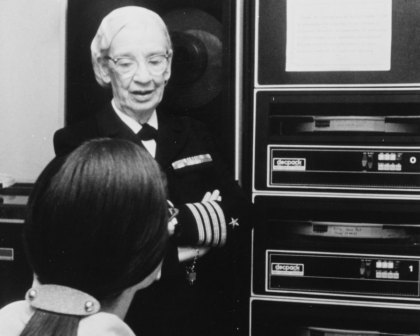Who was Yale University's Amazing Grace?
And now a Yale residence college has been named in honor of Hopper (1906-1992).
On Feb. 11, the school announced it would be putting Hopper’s name on a building previously known as Calhoun College after Yale alumnus John C. Calhoun. A vice president under John Quincy Adams and Andrew Jackson, Calhoun was known for his ardent support of slavery.
The university in 2016 announced it would keep Calhoun's name on the college, but recently decided to reverse that decision. Yale President Peter Salovey described Hopper as “an exemplar of achievement in her field and service to her country.”
Here are fast facts about the noteworthy veteran known in the Navy as amazing Grace:
Born: Dec. 9, 1906, in New York City.
Education: She graduated from Vassar College in 1928 with a degree in mathematics and physics. She then became an instructor at Vassar while continuing her studies at Yale, where she earned a master’s degree in 1930 and a doctorate in 1934.
Marriage: In 1930 she married Vincent Foster Hopper, a New York University professor. They divorced in 1945.
Military career: After Pearl Harbor (Dec. 7, 1941) Hopper attempted to join the military but was rejected because of her size, a Yale news release recounted. She tried again and in 1943 joined the U.S. Naval Reserve. She was assigned to the Bureau of Ordnance Computation Project at Harvard University, where she worked on computers. She remained in the military, either on active duty or as a reservist, for decades, becoming the oldest officer on active duty in 1982, according to The New York Times. She retired in 1986 with the rank of rear admiral.
Research fellow in engineering: In 1946 Hopper became a research fellow in engineering and applied physics at Harvard's Computation Laboratory. She coined the term “bug” to describe the various baffling issues that plague computers after a moth infiltrated the circuits of the computer, according to Encyclopedia Britannica's website. And in 1949 she took a position as senior mathematician for the Eckert-Mauchly Computer Corp.
Accomplishments: In 1952 “she and her team developed the first computer language ‘compiler,’ which would make it possible to write programs for multiple computers rather than a single machine,” recounts Yale.Hopper retired from the Navy reserve in 1966 but was recalled to active duty to standardize the Navy's computer programs and languages.
She was the recipient of Yale’s Wilbur Lucius Cross Medal, the National Medal of Technology, and, in 1996, a naval vessel was named for her. Hopper was also posthumously awarded the the Presidential Medal of Freedom in 2016.
To know more:
- Encyclopedia Britannica: Grace Hopper.
- The New York Times: Rear Adm. Grace M. Hopper dies; innovator in computers was 85.
- U.S. Navy: USS Hopper named for Rear Admiral "Amazing" Grace Hopper.
- U.S. Navy: Computer Science Legend, Rear Adm. Grace Hopper, Posthumously Receives Presidential Medal of Freedom.
- Vassar Encyclopedia: Grace Murray Hopper.
- White House: President Obama names recipients of the Presidential Medal of Freedom.
- Yale News: Grace Murray Hopper (1906-1992), A legacy of Innovation and Service.
- Yale News: Yale to change Calhoun College's name to honor Grace Murray Hopper.
Related:
Yale keeps Calhoun's name, drops 'master'
Princeton to keep Wilson's name on school
Georgetown confronts troubled history
Follow StudyHall.Rocks on Twitter.
If you would like to comment, give us a shout, or like us on Facebook and tell us what you think.


